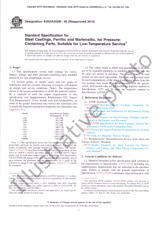We need your consent to use the individual data so that you can see information about your interests, among other things. Click "OK" to give your consent.
ASTM E1561-20
Standard Practice for Analysis of Strain Gage Rosette Data
Translate name
STANDARD published on 1.9.2020
The information about the standard:
Designation standards: ASTM E1561-20
Publication date standards: 1.9.2020
SKU: NS-1008093
The number of pages: 5
Approximate weight : 15 g (0.03 lbs)
Country: American technical standard
Category: Technical standards ASTM
The category - similar standards:
Annotation of standard text ASTM E1561-20 :
This practice defines a reference axis for each of the two principal types of rosette configurations and the equations used for three-element strain gage rosette data analysis. The primary uses of this analysis procedure are to determine the directions and magnitudes of the principal surface strains, and to determine residual stresses. This is important for consistency in reporting results and for avoiding ambiguity in data analysis, especially when computers are used. There are several possible sets of equations, but the set presented herein is perhaps the most common.
Keywords:
bending strain, Mohr´s circle of strain, rosette, shear strain, strain, strain gages, tensile strain ,, ICS Number Code 77.040.99 (Other methods of testing metals)
Additional information
| 1. Scope | ||||
|
1.1 The two primary uses of three-element strain gage rosettes are (a) to determine the directions and magnitudes of the principal surface strains and (b) to determine residual stresses. Residual stresses are treated in a separate ASTM standard, Test Method E837. This practice defines a reference axis for each of the two principal types of rosette configurations used and presents equations for data analysis. This is important for consistency in reporting results and for avoiding ambiguity in data analysis—especially when computers are used. There are several possible sets of equations, but the set presented here is perhaps the most common. 1.2 The equations in 4.2 and 4.3 of this practice are derived from infinitesimal (linear) strain theory. They are very accurate for the low strain levels normally encountered in the stress analysis of typical metal test objects. They become detectably inaccurate for strain levels greater than about 1 %. Rosette data reduction for larger strains is beyond the scope of this practice. 1.3 This international standard was developed in accordance with internationally recognized principles on standardization established in the Decision on Principles for the Development of International Standards, Guides and Recommendations issued by the World Trade Organization Technical Barriers to Trade (TBT) Committee. |
||||
| 2. Referenced Documents | ||||
|
We recommend:
Technical standards updating
Do you want to make sure you use only the valid technical standards?
We can offer you a solution which will provide you a monthly overview concerning the updating of standards which you use.
Would you like to know more? Look at this page.




 Cookies
Cookies
